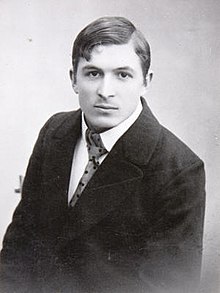Wäinö Aaltonen
| Wäinö Aaltonen | |
|---|---|

Aaltonen in early 20th century
|
|
| Born | March 8, 1894 |
| Died | May 30, 1966 (aged 72) |
| Occupation | sculptor |
| Years active | 1916-1961 |
| Notable work |
Paavo Nurmi statue, 1925 Aleksis Kivi statue, 1939 Statues in the plenary chamber of Parliament House |
| Spouse(s) | singer Aino Pietikäinen 1920 actor Elsa Rantalainen 1931 gallerist Elvi Hertell 1942 doctor Elisabet Maasik 1961. |
| Children | Matti Aaltonen |
Wäinö Valdemar Aaltonen (8 March 1894– 30 May 1966) was a Finnish artist and sculptor. The Chambers Biographical Dictionary describes him as "one of the leading Finnish sculptors".
He was born to a tailor in the village of Karinainen, Finland. He became interested in art after being deaf as a child, and attended the School of Drawing of the Turku Art Association from age 16, or specifically between 1910 and 1915. He had spent many of the early years at this school studying painting, but he was mainly self-taught as a sculptor. He learned the technics of treatment of marble with his relative Aarre Aaltonen, and by working as a trainee stone mason in Hirvensalo. Sculptor Felix Nylund was a substitute teacher in the art school in Turku for one season, and his work was inspiration for young Aaltonen.
A journey Aaltonen made to Italy in 1923 opened his eyes to cubist and futurist art. These elements can primarily be seen in his paintings.
As the Republic of Finland arose, and the First World War raged, he sculpted War Memorials. He soon became a nationalist icon, the exemplar Finn, establishing an exhibition in in 1927. His sculpture is nationalist in nature, and he is noted for monumental figures and busts portraying citizens of Finland. An example is the 1925 sculpture of Paavo Nurmi, a cast of which is exhibited outside the Helsinki stadium. Another notable work is that of Jean Sibelius, a bust of 1928. These two works, like the main body of his work, are bronze casts—though he did work in stone and even glass. Though chiefly naturalistic, the cubist influence is also present here. He was one of the early 20th-century pioneers of direct carving.
...
Wikipedia
